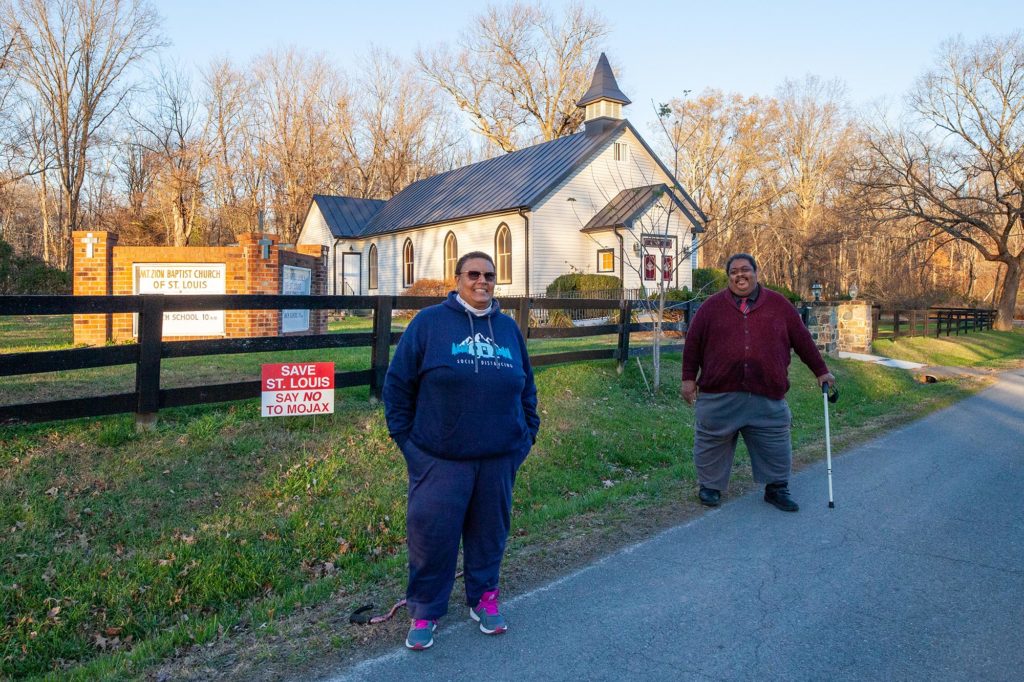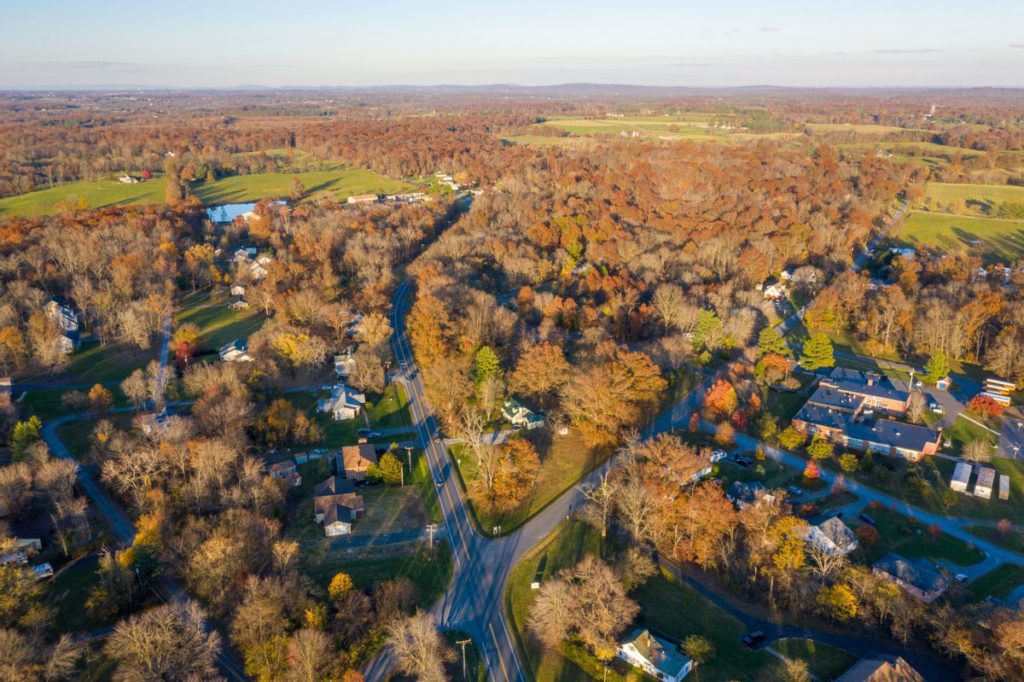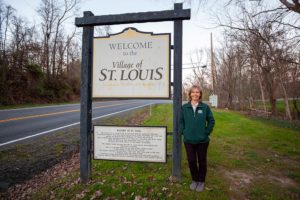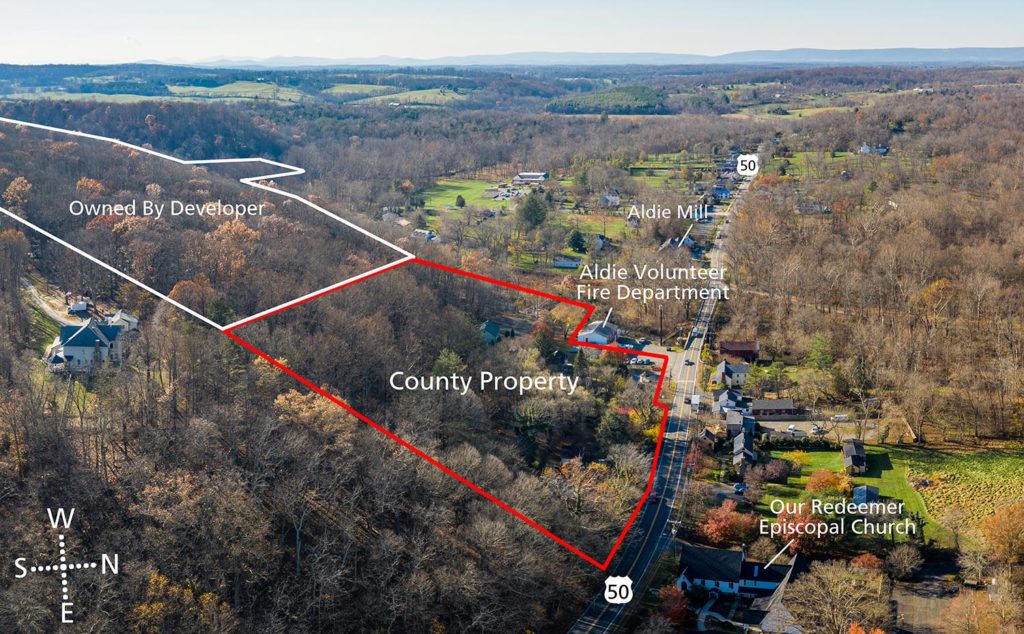
The signs at both entrances to the village of St. Louis proudly describe the hamlet as one of the oldest African American townships in Loudoun. It was built on land purchased by freed slaves for $20 an acre after Emancipation. St. Louis residents Sharon Peterson and Marcus Howard, descendants of some of these formerly enslaved St. Louis founders, still live there.
Their family names—McQuay, Berryman, Howard and others— go back five or more generations, forever memorialized in the names of various roads and structures that remain today. The story goes that Peterson’s great uncle, Phillip McQuay, was responsible for the village name. He moved to St. Louis, Missouri after the Civil War, and when he returned to Loudoun, the community dubbed him “Little St. Louis.” The name stuck and took on a life of its own.
St. Louis was already a growing community of some 100 residents by then. Its earliest public building, the one-room Hamlin School, was built before 1877 and still stands today as a (updated) private residence. The Howard and McQuay families were among several who joined together in 1893 to buy land for the founding of Mt. Zion Baptist Church, whose congregation remains faithful to this day. Peterson’s grandmother, Mattie McQuay Berryman, at one time owned some 300 acres, and Peterson lives in the home her great grandfather built in 1895. In 1876, Howard’s family bought 17 acres north and east of the church, along what’s now Snake Hill Road, and established the RobinsonHoward cemetery, the final resting place of more than a few dozen known and unknown Black community members.
Old Challenges and a New Threat
St. Louis and its residents have faced challenges, past and present, that echo those of African American communities across the country.
Land sold to Black residents in those days was often of poor quality for farming and largely neglected by local government; St. Louis is no exception. It is largely a wetlands area with poor drainage marked by the unmistakable odor of “rotten eggs” in the tap water. Many residents relied on springs for drinking water well into the mid-20th century. Septic-based indoor plumbing lagged, and once installed, high water tables often led to failed septic fields. At the same time, shallow wells are still susceptible to drying up as groundwater levels fluctuate with weather patterns and increased development.
By the end of the century, increased development became the bigger threat to St. Louis, and the Howard family’s original 17 acres are its latest battlefield. “As urban expansion began to reach St. Louis… new, more expensive homes went up, property taxes also went up, which had the domino effect of many ancestral families selling their land and homes,” Mt. Zion Baptist Church Pastor Charles Thompson wrote in an editorial to the Middleburg Eccentric.
When a developer, Mojax LLC, bought the Howards’ ancestral land in 2017 and proposed a development of 27 homes with individual wells, the community was understandably concerned. “As a widow and a senior citizen on a budget, the development could drive up the taxes and force me to dig a new well, which I can’t afford,” said Peterson. Besides the water issues and property values, residents worried about losing the historic cemetery, undiscovered graves of enslaved people, and the cultural history of the place.

The Fight for Preservation Takes Shape
The proposed development was a “byright” development, meaning county zoning rules allow for it without approval from the Board of Supervisors. There was little hope it could be stopped, but St. Louis was worth the effort of trying. Community members formed a Friends of St. Louis group to take on Mojax.
Friends of St. Louis dotted the community with red and white signs bearing the words “Save St. Louis. Say No To Mojax.” Dozens of people spoke out against the development at public meetings. Individuals filed complaints that Mojax was illegally impacting wetlands on the property. Protection of the historic burial grounds became a point of controversy.

“Everyone came together regardless of race or class. The demographics of the community have changed over the last 20 years, but the sense of community remains. The developer’s disregard for the community and our feelings was very upsetting,” Howard said.
Friends of St. Louis leaders Job Woodill, Sally Fletcher, and Jeff Jackson also turned to The Piedmont Environmental Council for help. “Our land use and historic preservation staff researched the St. Louis property in detail. The developer disturbed the wetlands on the property three times to drill wells without the proper state permits. We have provided input on orders to mitigate their violations and their federal permit,” said Gem Bingol, PEC’s Loudoun County field representative.
PEC successfully petitioned the Virginia Department of Historic Resources to add the former Howard property to the boundaries of the St. Louis Historic District and requested a Section 106 review under the National Historic Preservation Act of 1966. “Making a case that the development would destroy historic assets was our most likely way to reduce the impacts of the development on the community. At best it could reduce the number of houses; at worst, there might be some nominal recognition of the historic assets that were being destroyed,” Bingol said.
A Positive Outcome Turns Cloudy
In October 2020, following some two-and-a-half years of work and outcry by Friends of St. Louis, individual residents, PEC and others, Loudoun County’s Board of Supervisors took the unprecedented step of negotiating behind the scenes to buy the property at three times its assessed value. Local news media reported that a conservation easement would preserve the land in perpetuity and the county would work with the community to create a public park. Supervisor Phyllis J. Randall said, in a Loudoun Now article, that the Board of Supervisors was motivated by “the county’s obligation to care for a community it has neglected over the decades as the rest of the county has developed and become part of Loudoun’s ‘well-to-do’ culture.”
“Protecting villages like St. Louis, historically treated as second-class communities and imperiled by inadequate land use protections, is critically important to understand past injustices and document the contributions of these communities in our historical records,” said Kristie Kendall, PEC’s Historic Preservation Coordinator. For two short months, PEC, along with all who care about St. Louis, celebrated the county’s bold decision to step in.
But on Dec 1, the Board of Supervisors announced a much different purchase agreement, one initiated by the developer and that clearly serves its interests well. Under the new agreement, the County would still pay Mojax $1.5 million for the St. Louis property, but it would also give Mojax 6.31 acres of county-owned land in the village of Aldie, with frontage along Route 50 and wrapping around the back of the old fire station, and another $600,000 for improvements to that property, which happens to be adjacent to another property owned by one of the Mojax developers and currently lacks Route 50 access. The question on everyone’s mind is: Why?

“This developer has already shown disregard for both the Aldie and St. Louis communities in developing his various properties without the proper permits,” Bingol said. “What had been a seemingly noble and just act by the Loudoun Board of Supervisors is now a deal that potentially pits the two communities against one another and rewards a developer known to repeatedly disregard federal, state, and local regulations and ignore the concerns of residents.”
The new deal raises a whole new crop of questions and concerns that leave residents in both St. Louis and Aldie feeling vulnerable. Neither village has had the benefit of a county-led comprehensive planning process to determine their specific needs and consider their unique environmental and historic features. The fact that current zoning allows relatively high density development in both villages without consideration of these resources only magnifies the need for those steps.
“Shifting the negative impacts of ill-conceived development from one village to another is mystifying. Instead of an elegant solution, the new agreement has opened a hornets’ nest of angry frustration in both villages that we expect will be expressed during the public hearing currently set for January 13,” Bingol said.
A key aspect of PEC’s work is encouraging residents to actively engage in community decisions that directly impact their lives. PEC will continue to work with these communities for a fair and equitable resolution that preserves both villages’ history, culture and sense of place.
Update: At the January 13 public hearing, the Loudoun Board decided to delay the decision for the proposed Aldie/St. Louis land purchase/exchange deal. Read more >>
This article was written by Cindy Sabato and Gem Bingol and appeared in The Piedmont Environmental Council’s December 2020 member newsletter, The Piedmont View. If you’d like to become a PEC member or renew your membership, please visit pecva.org/join.
